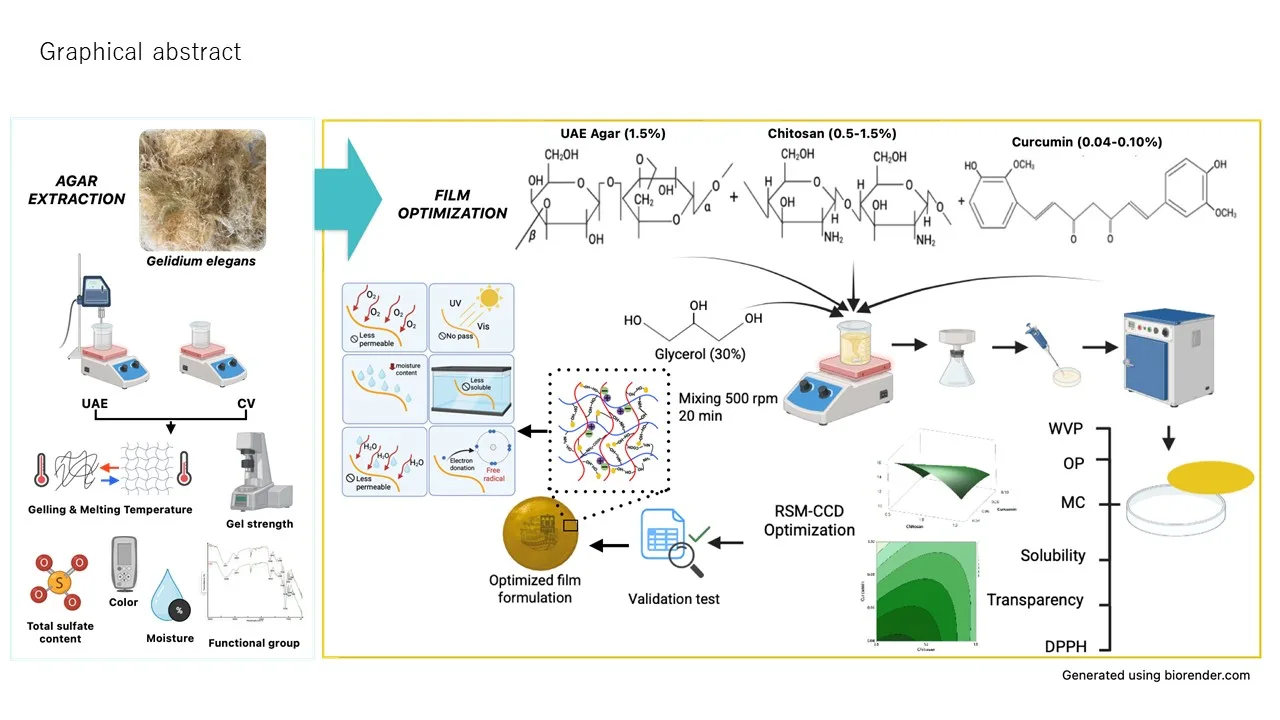

Valorization of agar extracted from Gelidium elegans via ultrasound-assisted extraction as potential film packaging by optimizing the incorporation of chitosan and curcumin
A research team led by Nor Alia Che Nozid, a doctoral student at the Graduate School of Integrated Science and Technology, Nagasaki University, Dr. Nor Hayati Ibrahim of University of Malaysia, Terengganu (an academic partner institution of Nagasaki University’s AFIMA Leaders Program), and Professor Katsuya Hirasaka of the Organization for Marine Science and Technology, Nagasaki University, has developed an eco-friendly food packaging material. The team analyzed the characteristics and functionality of food-grade films made from red seaweed polysaccharides, incorporating chitosan (a natural polysaccharide) and curcumin (a natural pigment and type of polyphenol).
These findings were published in the International Journal of Biological Macromolecules (Impact Factor: 8.5) on September 3, 2025.

This study characterized agar extracted from Gelidium elegans using ultrasound-assisted extraction (UAE) compared with conventional extraction (CV). The CV yielded significantly higher agar (21.50 %) than UAE (17.91 %); however, both methods produced stable agar with high melting temperatures (90.00 °C and 86.67 °C) and low moisture content (MC) (12.06 % and 14.94 %), respectively. UAE agar exhibited higher gel strength (218.58 g·cm−2) and gelling temperature (36.00 °C), desirable color, and lower sulfate content (0.46 %). UAE agar was further applied to optimize agar-based composite films as alternatives toward plastic packaging by incorporating varying levels of chitosan (0.5–1.0 % w/v) and curcumin (0.04–0.10 % w/v). Film properties including water vapor permeability (WVP), oxygen permeability (OP), MC, solubility, transparency, and 2-diphenyl-1-picrylhydrazyl (DPPH) antioxidant activity were evaluated using response surface methodology–central composite design (RSM-CCD). The model was validated, and the optimum formulation was chosen based on highest desirability (0.9096) at 0.5 % (w/v) chitosan and 0.07 % (w/v) curcumin. The optimized film exhibited WVP (2.38 × 10−10 g/msPa), OP (4.28 × 10−7 g/ms), MC (13.71 %), solubility (29.19 %), transparency (9.93), and DPPH activity (60.77 %), all within specified prediction ranges. These findings demonstrate that agar-based composite films incorporating with chitosan and curcumin provides good validation of model prediction and hold strong potential for eco-friendly food packaging applications.
Journal: International Journal of Biological Macromolecules
Title: Valorization of agar extracted from Gelidium elegans via ultrasound-assisted extraction as potential film packaging by optimizing the incorporation of chitosan and curcumin
Authors:
Nor Alia Che Nozid
Institute of Integrated Science and Technology, Nagasaki University
Nor Hayati Ibrahim
Faculty of Fisheries and Food Science, Universiti Malaysia Terengganu
Asami Yoshida
Institute of Integrated Science and Technology, Nagasaki University
Youshi Huang
Institute of Integrated Science and Technology, Nagasaki University
Takuya Hirose
Institute of Integrated Science and Technology, Nagasaki University
Katsuya Hirasaka
Organization for Marine Science and Technology, Nagasaki University
Corresponding Author:
Katsuya Hirasaka
DOI: https://doi.org/10.1016/j.ijbiomac.2025.147323
Publication Date: September 3, 2025
For more details, please see the full article on Nagasaki University’s Academic Output SITE.